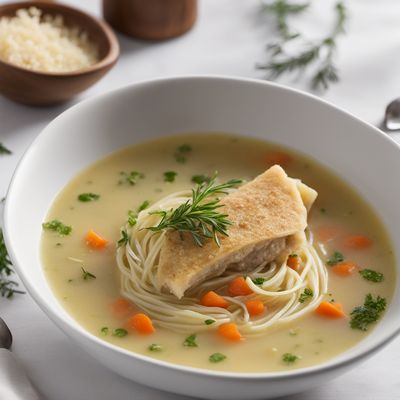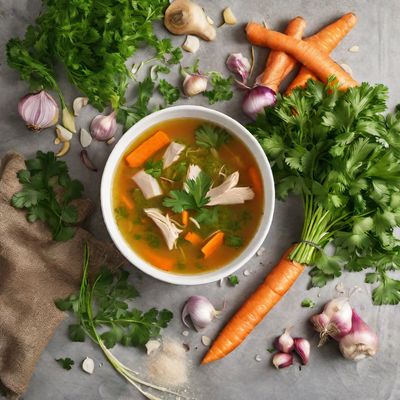
Ingredient
Root parsley leaves
The Hidden Gem: Unveiling the Versatility of Root Parsley Leaves
Root parsley leaves are characterized by their vibrant green color and feathery appearance. They have a mild, slightly sweet flavor with hints of celery and parsley. The leaves are tender and can be used as a garnish, added to salads, or incorporated into soups, stews, and sauces for an extra layer of freshness and depth of flavor.
Origins and history
Root parsley, or Petroselinum crispum var. tuberosum, is a variety of parsley that is cultivated for its edible root and leaves. It is believed to have originated in the Mediterranean region and has been used in cooking for centuries. Root parsley leaves were traditionally used in European cuisines, particularly in German and Eastern European dishes. Today, they are enjoyed worldwide for their unique taste and versatility.
Nutritional information
Root parsley leaves are low in calories and a good source of vitamins A, C, and K. They also contain minerals such as potassium and calcium. Incorporating root parsley leaves into your meals can contribute to a well-rounded and nutritious diet.
Allergens
May cause allergic reactions in individuals with celery or parsley allergies.
How to select
When selecting root parsley leaves, look for fresh, vibrant leaves that are free from wilting or yellowing. The leaves should have a crisp texture and a fragrant aroma. If purchasing from a farmers market, choose bunches with intact roots, as they can be used in cooking as well. Avoid leaves that appear bruised or damaged.
Storage recommendations
To keep root parsley leaves fresh, remove any rubber bands or ties and store them in a plastic bag or container lined with a damp paper towel. Place the bag or container in the refrigerator's crisper drawer, where the leaves can stay fresh for up to a week. Alternatively, you can trim the ends of the stems and place the leaves in a glass of water, similar to a bouquet of flowers, to prolong their freshness.
How to produce
Root parsley can be grown in home gardens or containers with relative ease. Start by sowing seeds in well-draining soil and providing regular watering. The leaves can be harvested as needed, and the root can be dug up once it reaches a desirable size. With proper care, you can enjoy a steady supply of fresh root parsley leaves throughout the growing season.
Preparation tips
Root parsley leaves can be used in a variety of dishes, including salads, soups, stews, sauces, and stir-fries. They can be chopped and added as a garnish or used as a flavoring agent to enhance the taste of various recipes. Experiment with different cooking techniques, such as blanching or sautéing, to explore the versatility of root parsley leaves.
Substitutions
Celery leaves or regular parsley leaves can be used as substitutes for root parsley leaves. However, keep in mind that the flavor profile may differ slightly, so adjust the quantity accordingly.
Culinary uses
Root parsley leaves are commonly used in German and Eastern European cuisines. They are often featured in traditional dishes like goulash, potato soup, and root vegetable stews. Additionally, they can be found in Mediterranean recipes, such as tabbouleh or parsley pesto, where their fresh taste adds a delightful twist.
Availability
Root parsley leaves are commonly available in Europe, particularly in Germany, Eastern European countries, and the Mediterranean region. They can also be found in some specialty grocery stores or farmers markets in other parts of the world.
More ingredients from this category
Recipes using Root parsley leaves » Browse all

Mughlai-inspired Fattoush Salad
Royal Fattoush: A Mughlai Twist to a Levantine Classic

Bavarian-style Nasi Goreng
Bavarian Fusion: A Twist on Indonesian Nasi Goreng

French-inspired Souvlaki
Savory Grilled Skewers with a French Twist

Molecular Chicken Parmigiana
The Gastronomic Transformation of Chicken Parmigiana

Kung Pao Chicken
Hungarian-style Spicy Chicken with Peanuts

Scrippelle 'mbusse - Italian Crepe Soup
Velvety Italian Crepe Soup: A Comforting Delight

Croatian-Style Chicken Soup
Hearty Croatian Chicken Soup: A Taste of Tradition

Latvian-style Sea Urchins with Green Sauce
Baltic Delicacy: Latvian Sea Urchins with Zesty Green Sauce

Roman-style Albondigas Soup
Savory Meatball Delight: Roman-style Albondigas Soup

Jordanian Apple Salad
Tangy Delight: Jordanian Apple Salad with a Twist

Şakşuka - Latvian Style
Latvian Inspired Şakşuka: A Hearty Vegetable Delight

Pizza Valdostana with a Twist
Savory Delight: A Modern Twist on Pizza Valdostana